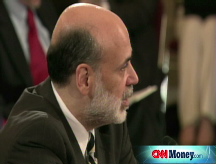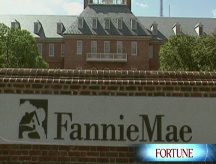Fannie, Freddie: Taxpayers on the hook
How big a burden taxpayers would bear if Uncle Sam lends a hand to the two mortgage finance giants depends on a lot of hard-to-estimate variables.
NEW YORK (CNNMoney.com) -- Saving Fannie Mae and Freddie Mac could cost the U.S. taxpayer. But so could letting the two mortgage giants collapse.
A rescue plan that uses federal dollars would risk increasing the deficit and possibly lowering the U.S. debt rating, making it more expensive for the government to borrow in the future. A decision not to intervene could lead to deep pain in the mortgage market and the parts of the economy tied to it.
The Bush administration is betting the first option is preferable to the second.
A proposal outlined by Treasury Secretary Henry Paulson - if approved by Congress - would offer explicit backing for the two government-sponsored enterprises (GSEs). It has three main elements.
- Increase each company's $2.25 billion line of credit with the Treasury by an unlimited amount for the next 18 months.
- Let the Treasury have the option of buying an unlimited amount of Fannie and Freddie stock over the next 18 months.
- Give the Federal Reserve a consultative role with the GSEs' regulator to assess the companies' capital requirements.
In any rescue, Treasury would likely have to borrow billions of dollars. Exactly how much it would cost taxpayers is impossible to gauge because of several unknowns. Among them are extreme volatility in the companies' stock prices coupled with falling home values and rising mortgage default rates, which affect the value of the GSEs' assets and debt.
"Stuff's happening to the portfolio that we don't know about," said Lee Sheppard, a contributing editor at Tax Analysts. "It's a fluid situation."
And maybe the biggest unknown: just how much the government might spend on Fannie and Freddie.
"Let me stress there are no immediate plans to access either the proposed liquidity or the proposed capital backstop," Paulson told the Senate Banking Committee on Tuesday.
Paulson said he had a reason for not proposing a cap on the new line of credit or on the amount of GSE stock the Treasury could buy.
"By having something that's unspecified, it will increase confidence and decrease the likelihood that [the liquidity and capital backstops] will ever be used," he said. "If you have a bazooka in your pocket and people know it, you probably won't have to take it out."
Without specifying how, Paulson added that if and when the government does commit money, "we have to look carefully at ways to protect the taxpayers."
A number of senators on the banking committee - from both parties - characterized Paulson's request as asking lawmakers for a "a blank check," and they were none too keen on the idea, knowing they have to answer to taxpayers.
How lawmakers might alter the Treasury's proposals isn't clear yet. But if the government uses federal dollars to help Fannie and Freddie, the cost to taxpayers could be minimal if the rescue plan works. That is, if government efforts bolster the companies, they likely would be able to pay back what they owe.
"Taxpayers may get it all back with interest," said Rudolph Penner, a former director of the Congressional Budget Office and currently a senior fellow at the Tax Policy Center.
But the taxpayer cost could increase if Fannie (FNM, Fortune 500) and Freddie (FRE, Fortune 500) default on their debt or if their stocks lose value. This year, they've already fallen over 80%, with the bulk of those losses coming this month.
The costliest rescue potentially would be if the government decides to take over the two companies. Both Paulson and President Bush on Tuesday stressed that they want Fannie and Freddie to remain shareholder-owned companies.
But if a takeover does occur - or even if the government just buys a very large equity stake - taxpayers would effectively take over the debt obligations of Fannie and Freddie.
Currently, the two companies own or back $5 trillion in debt. But the ultimate debt burden to taxpayers would likely be only a small percentage of $5 trillion because that debt is backed by assets with value - homes - and because the majority of the loans they own or back are the more stable 30-year fixed-rate mortgages.
At the end of the day, a taxpayer bill is "nothing to sneeze at - I wouldn't shrug it off," Penner said.
But, he added, it's unlikely the debt from a rescue would come close to some of the government's biggest fiscal burdens, such as Medicare. The amount of general revenue that will be required to pay for Medicare in the next three years alone approaches $600 billion, according to the Concord Coalition, a deficit watchdog group. And that's on top of the premiums and Medicare taxes Americans will pay in to the system.
Long-term, the potential downside of a Fannie-Freddie intervention could increase taxpayer costs in other ways. One of them: It could help drag down the government's top-notch credit rating.
A report issued this spring by the credit rater Standard & Poor's estimates that if the U.S. economy hits a long recession, government help for the GSEs "could create a material fiscal burden to the government that would lead to downward pressure on its rating."
The danger to the credit rating wouldn't necessarily come just from the Treasury stepping in. Rather, it would result from a confluence of events stemming from problems at the GSEs, such as slowing economic growth and a reluctance among foreigners to buy more U.S. debt, said John Chambers, managing director and chairman of S&P's sovereign rating committee.
A downgrade in the U.S. credit rating would make it more expensive for the government to borrow. And that means the cost of public debt - currently $4.5 trillion - would grow more expensive.
Practically speaking, it's unlikely taxpayers would feel an immediate pinch from any unreimbursed costs of a rescue. "Would the taxpayer notice it? Probably not. But it will increase the amount of federal debt," Penner said.
And that will increase pressure on future administrations to either raise taxes or cut spending, or both. ![]()





